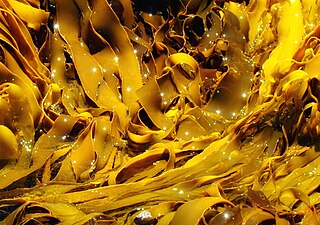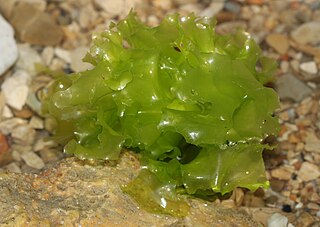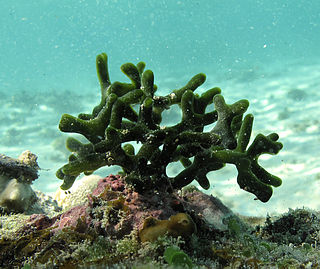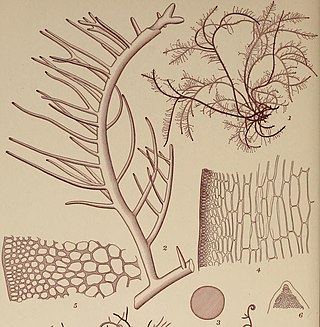
Algae are any of a large and diverse group of photosynthetic, eukaryotic organisms. The name is an informal term for a polyphyletic grouping that includes species from multiple distinct clades. Included organisms range from unicellular microalgae, such as Chlorella, Prototheca and the diatoms, to multicellular forms, such as the giant kelp, a large brown alga which may grow up to 50 metres (160 ft) in length. Most are aquatic and lack many of the distinct cell and tissue types, such as stomata, xylem and phloem that are found in land plants. The largest and most complex marine algae are called seaweeds. In contrast, the most complex freshwater forms are the Charophyta, a division of green algae which includes, for example, Spirogyra and stoneworts. Algae that are carried by water are plankton, specifically phytoplankton.

Phycology is the scientific study of algae. Also known as algology, phycology is a branch of life science.

Brown algae are a large group of multicellular algae comprising the class Phaeophyceae. They include many seaweeds located in colder waters of the Northern Hemisphere. Brown algae are the major seaweeds of the temperate and polar regions. Many brown algae, such as members of the order Fucales, commonly grow along rocky seashores. Most brown algae live in marine environments, where they play an important role both as food and as a potential habitat. For instance, Macrocystis, a kelp of the order Laminariales, may reach 60 m (200 ft) in length and forms prominent underwater kelp forests that contain a high level of biodiversity. Another example is Sargassum, which creates unique floating mats of seaweed in the tropical waters of the Sargasso Sea that serve as the habitats for many species. Some members of the class, such as kelps, are used by humans as food.

The sea lettuces comprise the genus Ulva, a group of edible green algae that is widely distributed along the coasts of the world's oceans. The type species within the genus Ulva is Ulva lactuca, lactuca being Latin for "lettuce". The genus also includes the species previously classified under the genus Enteromorpha, the former members of which are known under the common name green nori.

Oedogonium is a genus of filamentous, free-living green algae. It was first discovered in the fresh waters of Poland in 1860 by W. Hilse, and later given its name by German scientist K. E. Hirn.

Porphyra is a genus of coldwater seaweeds that grow in cold, shallow seawater. More specifically, it belongs to red algae phylum of laver species, comprising approximately 70 species. It grows in the intertidal zone, typically between the upper intertidal zone and the splash zone in cold waters of temperate oceans. In East Asia, it is used to produce the sea vegetable products nori and gim. There are considered to be 60–70 species of Porphyra worldwide and seven around Britain and Ireland, where it has been traditionally used to produce edible sea vegetables on the Irish Sea coast. The species Porphyra purpurea has one of the largest plastid genomes known, with 251 genes.

Codium is a genus of edible green macroalgae under the order Bryopsidales. The genus name is derived from a Greek word that pertains to the soft texture of its thallus. One of the foremost experts on Codium taxonomy was Paul Claude Silva at the University of California, Berkeley. Silva was able to describe 36 species for the genus, and in honor of his work on Codium, the species C. silvae was named after the late professor.

Atractophora hypnoides is a rare red alga (Rhodophyta) found in the British Isles, France and some Atlantic Islands and is the only species of the genus found in the British Isles. It is attached to the rock or other algae by a small basal disc and is much branched with downgrowing filaments which enclose the main branch or axis forming a cortex. Short filaments of limited growth radiate in whorls from the axis and frequently convert into hairs. The spreading filaments grow irregularly in a diffuse manner. Microscope examination is required for identification.
Panmixia means uniform random fertilization. A panmictic population is one where all potential parents may contribute equally to the gamete pool, and that these gametes are uniformly distributed within the gamete population (gamodeme). This assumes that there are no hybridising restrictions within the parental population: neither genetics, cytogenetics nor behavioural; and neither spatial nor temporal. Therefore, all gamete recombination (fertilization) is uniformly possible. Both the Wahlund effect and the Hardy Weinberg equilibrium assume that the overall population is panmictic.
In botany, a zoid or zoïd is a reproductive cell that possesses one or more flagella, and is capable of independent movement. Zoid can refer to either an asexually reproductive spore or a sexually reproductive gamete. In sexually reproductive gametes, zoids can be either male or female depending on the species. For example, some brown alga (Phaeophyceae) reproduce by producing multi-flagellated male and female gametes that recombine to form the diploid sporangia. Zoids are primarily found in some protists, diatoms, green alga, brown alga, non-vascular plants, and a few vascular plants. The most common classification group that produces zoids is the heterokonts or stramenopiles. These include green alga, brown alga, oomycetes, and some protists. The term is generally not used to describe motile, flagellated sperm found in animals. Zoid is also commonly confused for zooid which is a single organism that is part of a colonial animal.

Bryopsis, often referred to a hair algae, is a genus of marine green algae in the family Bryopsidaceae. Species in the genus are macroscopic, siphonous marine green algae that are made up of units of single tubular filaments. They can form dense tufts up to 40 cm in height. Each cell is made of up an erect thallus that is often branched into pinnules. Approximately 60 species have been identified in this genus since its initial discovery in 1809. The ecological success of Bryopsis has also been attributed to its associations with endophytic bacteria that reside in the cytoplasm of their cells.
Ulva ohnoi is a species of light-green coloured seaweed in the family Ulvaceae that is endemic to Japan.

Blidingia minima is a species of seaweed in the Kornmanniaceae family. It was described by Johann Kylin in 1947.

Hypnea is a genus of red algae, and a well known carrageenophyte.

Furcellaria is a genus of red algae. It is a monotypic genus, the only species being Furcellaria lumbricalis, which has commercial importance as a raw material for carrageenan production. It is mainly harvested from the waters of Denmark and Canada.
Monostroma kuroshiense, a green alga in the division Chlorophyta, is a green seaweed endemic to Kuroshio Coast of Japan. This high-value seaweed is called Hitoegusa or Hirohano hitoegusa (ヒロハノヒトエグサ) in Japanese. Previously this algae was known in binomen Monostroma latissimum, but the latest scientific research based on multilocal phylogeny discovered that this is a new species. The algae is named after Kuroshio Current, naming is done by phycologist Felix Bast This algae is commercially cultivated in East Asia and South America for the edible product "hitoegusa-nori" or "hirohano-hitoegusa nori", popular sushi wraps. Monostroma oligosaccharides with degree of polymerization 6 prepared by agarase digestion from Monostroma nitidum polysaccharides have been shown to be an effective prophylactic agent during in vitro and in vivo tests against Japanese encephalitis viral infection. The sulfated oligosaccharides from Monostroma seem to be promising candidates for further development as antiviral agents. The genus Monostroma is the most widely cultivated genus among green seaweeds.
Sirogonium is a genus of filamentous charophyte green algae of the order Zygnematales. It is found in freshwater areas on all continents but Antarctica. Spirogyra measures approximately 32–115 μm in width. Each cell contains 2–10 chloroplasts in a ribbon, in contrast to the closely related genus Spirogyra, which has chloroplasts in a coil. Molecular phylogenetic studies have placed Sirogonium inside a clade consisting of Spirogyra species; in other words, Spirogyra is paraphyletic with respect to Sirogonium.

Felix Bast, born as V. M. Sreejith Nambissan, is an Indian phycologist, author, and public educator based at the Central University of Punjab. He is the member of the high-profile advisory council of International Science Council, Paris, and has discovered seven new species of plants from India and Antarctica.

Mustafa Shameel was a Pakistani scientist and educator noted for his work in the fields of barobiology, phycochemistry and taxonomy of algae. He spent most of his five decades' academic career at the University of Karachi.
A mycophycobiosis (composed of myco-, from the Ancient Greek: μύκης, phyco-, from Ancient Greek: φῦκος,, and -biose, from ancient Greek: βιόω is a symbiotic organism made up of a multicellular algae and an ascomycete fungus housed inside the algae. The algae and fungus involved in this association are called mycophycobionts.

















